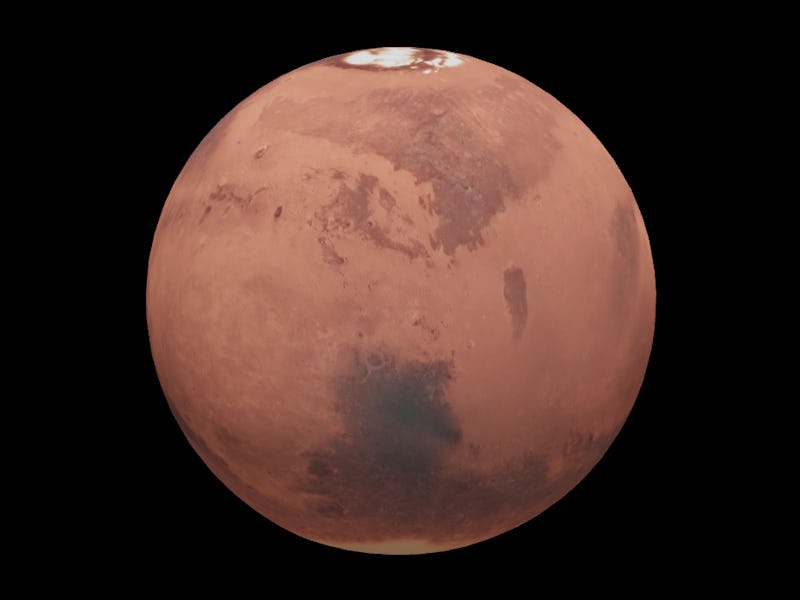A Martian meteorite may solve the planet’s ancient water mystery
Where did the water on Mars come from?

In 2011, a piece of Mars was found in the Sahara desert.
The shiny, black single stone weighing at around 11 ounces was dubbed as Northwest Africa (NWA) 7034, and nicknamed "Black Beauty," for its mesmerizing qualities.

Black Beauty holds clues to Mars' origin story beneath its shiny surface.
In a study published Monday in the journal Nature Geoscience, a team of scientists analyzed the meteorite in order to reconstruct the history of water on Mars.
Scientists have been trying to figure out Mars’ water history, and where the water originated on the Red Planet, in order to learn how Mars turned into a dry, desolate planet.
And of course, the history of water on Mars always includes the somewhat likely scenario that if Mars had water, well, Mars had life. Aliens. Martians.
The new findings suggest that there were likely two different sources of water on Mars during the planet’s early history, challenging theories that the Red Planet may have had a single global ocean.
Water World? — Billions of years ago, Mars may have been a warm, wet world with a thick atmosphere. But over time, the thick atmosphere was stripped from the planet. Other planets like Jupiter, Saturn, and even Earth also experience what's called atmospheric escape.
In order to understand how Mars changed, scientists needed to answer an even bigger question: How water got to the planet in the first place.
The team of scientists behind the new study analyzed two Martian meteorites — Black Beauty and Allan Hills. The latter was found in the Allan Hills in Antarctica in December 1984 and believed to have originated on Mars.
The two meteorites contain samples of Martian crust.
A newly formed impact crater on the Martian surface that formed between July and September, 2018.
The scientists conducted a chemical analysis of the samples, looking for two types of hydrogen isotopes. Light hydrogen has one proton in its nucleus, while heavy hydrogen has a proton and a neutron.
Figuring out the ratio of these two types of hydrogen in their samples could help scientists identify the source of water on Mars.
On Earth, water locked in rocks has a pretty standard ratio of light and heavy hydrogen that translates to ocean water. But Mars’ atmosphere is dominated by heavy hydrogen.
However, when looking at the ratios of hydrogen in the Martian meteorites, the values were not consistent, and instead were somewhere between Earth rocks and Mars’ atmosphere.
The study found two geochemically different types of Martian volcanic rocks, enriched shergottites, which have more heavy hydrogen isotopes, and depleted shergottites, which are more similar to the composition we have on Earth.
Scientists had previously tried to justify this variability in hydrogen isotopic ratios by saying that other objects from space may have landed on Mars, and caused terrestrial contamination or atmospheric implantation.
"Martian meteorites basically plot all over the place, and so trying to figure out what these samples are actually telling us about water in the mantle of Mars has historically been a challenge,” Jessica Barnes, assistant professor of planetary sciences in the University of Arizona Lunar and Planetary Laboratory, and lead author of the study, said in a statement. “The fact that our data for the crust was so different prompted us to go back through the scientific literature and scrutinize the data."
Dry ice on Mars' polar caps.
Not Earth-like — Scientists had previously believed that Mars formed in a similar fashion to Earth, through rock, dust, and gas that was leftover from the formation of the Solar System and evolved over time to form a planetesimal.
A planetesimal is basically a planet fetus that grew to form the planets we know today.
However, this new study suggests Mars may have been the result of two planetesimals colliding creating a planet with two different source of water.
“The prevailing hypothesis before we started this work was that the interior of Mars was more Earth-like and unfractionated,” Barnes said.
The new study points to an entirely different origin story for the water on Mars and may aid upcoming missions such as NASA’s Perseverance rover in their search for life on the Red Planet.